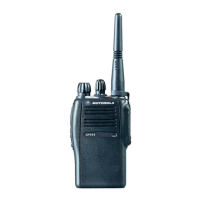Receiver (for models with PCB 8415533H02) 1-7
The output of the post-RF amplifier filter is connected to the passive double balanced mixer which
consists of T3301, T3302 and CR3301. Matching of the filter to the mixer is provided by C3317,
C3318 and L3308. After mixing with the first LO signal from the voltage controlled oscillator (VCO)
using high side injection, the RF signal is down-converted to the 44.85 MHz IF signal.
The IF signal coming out of the mixer is transferred to the crystal filter (Y3200) through a resistor pad
(R3321 - R3323) and a diplexer (C3320 and L3309). Matching to the input of the crystal filter is
provided by C3201 and L3200. The crystal filter provides the necessary selectivity and
intermodulation protection.
4.2 Receiver Back-End
The output of crystal filter Y3200 is matched to the input of IF amplifier transistor Q3200 by L3203.
Voltage supply to the IF amplifier is taken from the receive 5 volts (R5). The IF amplifier Q3200 is
actively biased by a collector base feedback provided by R3202 and R3203. The gain controlled IF
amplifier provides a maximum gain of about 16dB. A dual hot carrier diode (CR3201) limits the filter
output voltage swing to reduce overdrive effects at RF levels above -27dBm. The amplified IF signal
is then coupled into U3220 (pin 1) via L3202, C3207, and C3200 which provides the matching for the
IF amplifier and U3220.
The IF signal applied to pin 1 of U3220 is amplified, down-converted, filtered, and demodulated, to
produce the recovered audio at pin 7 of U3220.
Within U3220, the first IF 44.85 MHz signal mixes with the 44.395 MHz second local oscillator (2nd
LO) to produce the second IF signal at 455 kHz. The 2nd LO signal frequency is determined by
crystal Y3201. The second IF signal (455 kHz) is then filtered by an external ceramic filter Y3205
before being amplified by the second IF amplifier within U3220. Again, the signal is filtered by a
second external ceramic filter Y3203 or Y3204 depending on the selected channel spacing. Y3203 is
used for 20/25 kHz channel spacing whereas Y3204, for 12.5 kHz channel spacing. The simple circuit
consisting of U3221, CR3202, CR3203 and resistors R3209, R3212, R3211 and R3205 divert the
second IF signal according to the BW_SEL line. The filtered output of the second IF signal is applied
to the limiter input pin of U3220 (Pin 14).
The IF IC (U3220) contains a quadrature detector using a ceramic phase-shift element (Y3202) to
provide audio detection. Internal amplification provides an audio output level around 120mVrms
(@60% deviation) from pin 8 of U3220. This demodulated audio is fed to the ASFIC_CMP IC (U404)
in the controller section.
The IF IC (U3220) also performs several other functions. It provides a received signal-strength
indicator (RSSI) with a dynamic range of 70 dB. The RSSI is a dc voltage monitored by the
microprocessor, and used as a peak indicator during the bench tuning of the receiver front-end
varactor filter.

